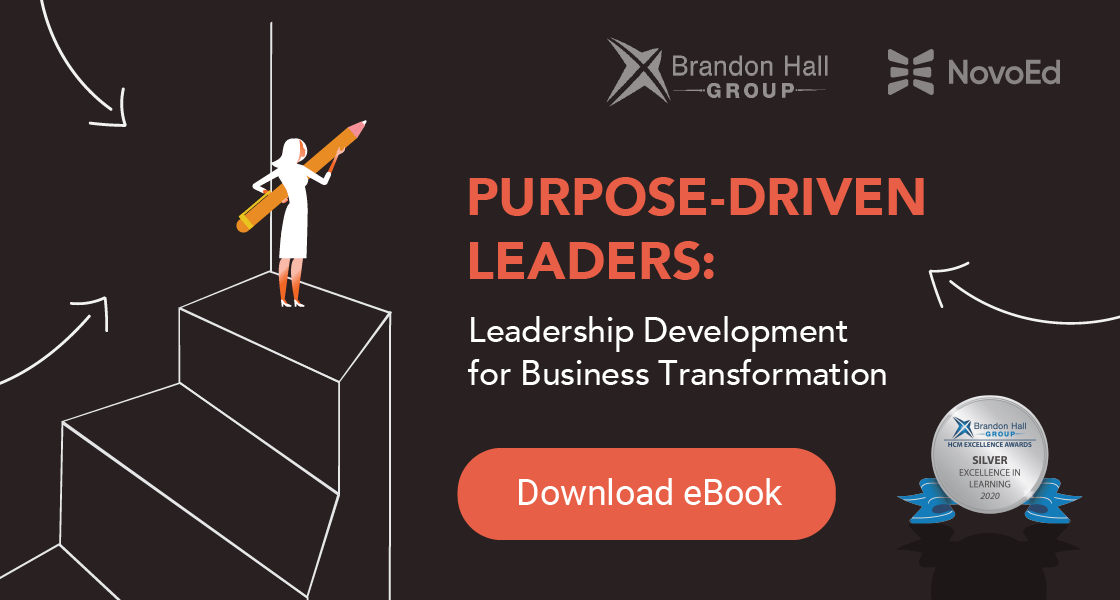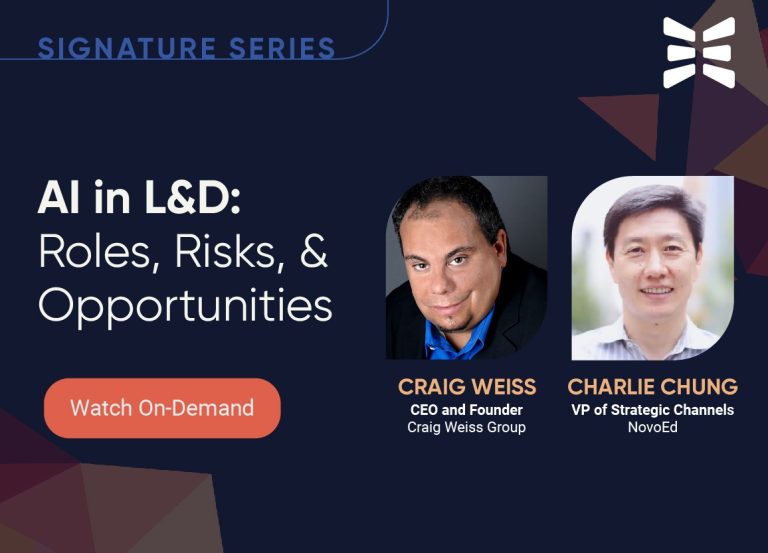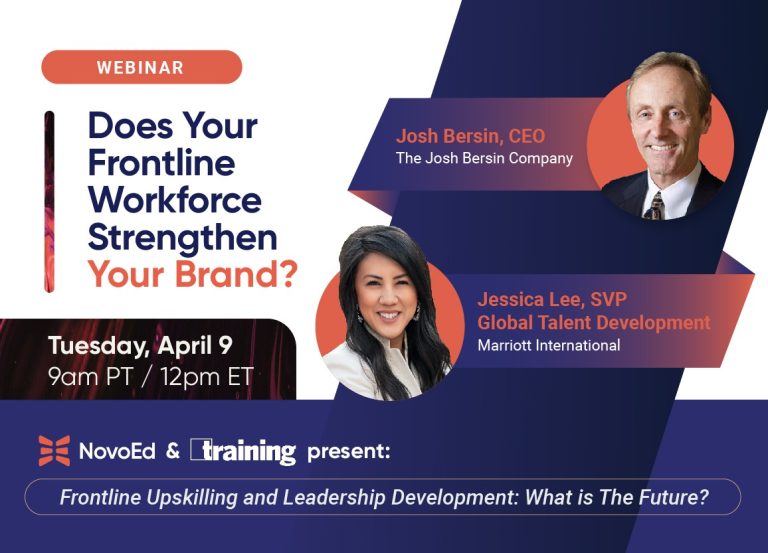10 Things Corporate Learning Leaders Need to Know About Purpose
What should the purpose of a company be? In 2019, the Business Roundtable declared that corporations should have a purpose that doesn’t just serve shareholders, but also considers the needs and values of customers, employees, suppliers, and communities. The cascade of health, economic, social, and environmental crises of 2020 (that continue into 2021) has challenged corporations to define their purpose in entirely new ways and create alignment between the purpose of the organization and those of its stakeholders.
As organizations plot their path to the future, reinventing the workplace and the jobs of the future, purpose appears to play a critical role in talent acquisition, workforce development, and career growth.
How should learning and development (L&D) leaders engage? Over the past six months, we’ve collaborated with RedThread Research’s Dani Johnson and Stacia Sherman Garr and Learning Futures Group’s Chris Pirie on a 10-part podcast series, Is Purpose Working? Industry and thought leaders from organizations including EY, GSV Ventures, IDEO U, Imperative, Johnson & Johnson, Medtronic, Sanofi, and S&P shared their perspectives on purpose, how it works at their organizations, and how corporate learning plays a role in achieving purpose.
Our journey culminated in a panel discussion, “The Role of Purpose in Supercharging Workplace Learning,” where we reflected on the series with Stacia Sherman Garr and Chris Pirie to cut through the hype and discuss how corporate learning professionals should engage with purpose.
Here are ten key takeaways for L&D leaders:
1. Purpose provides meaning in a time of flux
Many of us are struggling to identify what our purpose is after a year that saw the world turned upside down. It’s only natural to wonder why we spend our time doing what we do, and why we work with the people we do. As Stacia Sherman Garr noted during our debrief, “if the organization itself can’t answer those questions and doesn’t have clarity, it’s very difficult for people to make that connection.”
Voice of the expert:

“It’s about what gets you up in the morning—what energizes you? What do you want to make sure you have before you leave? These are the questions that speak to personal purpose, rather than just organizational purpose.”
— Dani Johnson, RedThread Research
2. Purpose isn’t just branding
Discussions about purpose might sometimes veer towards being frothy, but there is real substance to the concept, especially after a global pandemic. In 2021, purpose isn’t just about organizations doing things outside of their traditional remit because of Covid. It’s also about individuals asking themselves why they are working, what they are doing. “With the pandemic, purpose became this thing that was front and center,” noted Stacia.
Chris Pirie observed that the pandemic was a perfect lens through which to dig into this and see whether there was truth to these ideas. “What we learned was extraordinary,” he declares. “What we learned was that all of that anxiety about what technology is doing to the workplace, really served to underscore our collective humanity—and this idea of purpose became really powerful.”
3. Purpose is more than ‘good deeds’ alone
Conversations over the season clearly showed that purpose cannot be solely equated to corporate social responsibility or other altruistic corporate initiatives. Instead, we should think about purpose as a way to define what the company we work in is for, in the sense of what is the ultimate end of our common activities?
Creating an explicit, company-wide statement of purpose can end up framing purpose as an internal constitution that can be referred to as guidance for both tactical and strategic decision making. With clarity of purpose, it becomes easier to make strategic decisions, noted Chris. “You’ve got a North Star,” he says. “You’re also enabled to build a really powerful culture.”
Voice of the expert:

“It’s something that’s been written on a very, very important paper, it’s revered, all employees know it, and if we were to change it, it would be a massive organizational effort and massive internal debate to make a shift.”
— Jeff Orlando, Medtronic | Episode 3
4. Purpose is compatible with making money
Time and time again in the series, we heard hard-headed business people say that purpose makes them operate more optimally; that it is a catalyst for increased delivery, not the opposite. One interviewee, GSV Ventures’ Deborah Quazzo, was clear that her team will not fund an EdTech start-up unless the founder has a clear purpose statement or a convincing, achievable business plan.
Voice of the expert:

“We believe that companies with purpose have stronger cultures and are going to inherently have stronger outcomes.”
— Deborah Quazzo, GSV Ventures | Episode 8
We also see that being a purpose-led operation can help to increase customer loyalty. RedThread Research found that 67% of consumers are likely to forgive a mistake made by a purpose-driven organization, for example.
5. Purpose supports human capital metrics requirements
SEC requirements relating to human capital metrics were put into place last November, and companies are now beginning to grapple with those requirements in their 10Ks.
Stacia provides a tool to help. “I think this idea of what value does our human capital bring will be better articulated when we say we’re trying to achieve this, and our group of 35,000 employees all understand that and are doing the same thing,” she says. “This concept of metrics, and human capital metrics in particular, is becoming more relevant.”
6. Purpose and the talent pipeline create a highly potent mix
As we become more familiar with the idea of organizational purpose, the link between purpose and development will become clearer. Stacia predicts that the 2020-21 global health crisis will change how we approach recruitment in future, with purpose becoming a major factor. She says, “If an organization can show they have purpose, those are the organizations that are going to reap the talent benefits.”
7. Corporate learning can create cultures of purpose
Learning leaders can play an important role in creating a culture that reinforces purpose. “It’s asking how we talk about purpose in leadership development programs, and reinforce it in the conversations we’re having,” adds Stacia.
Many L&D teams are already playing an active role in these conversations, whether they know it or not. “L&D teams are a massive engine for perpetuating culture, but if your culture is about doing required training and hitting compliance metrics, that’s one thing,” according to Chris. “It’s a much higher order of work if you’re thinking about culture as helping people understand why the organization does what it does, and how their personal goals and purpose fit into that.”
There is a big opportunity for L&D teams to make this happen, says Chris. “It’s a massive opportunity and there are very tangible, practical things you can do as a learning leader to make this happen.”
Voice of the expert:

“We view the role of L&D as having a role in helping people become better performers, colleagues, leaders, better people… helping people discover and activate their purpose and vision almost immediately makes them better in all of those categories.”
— Tal Goldhamer, EY | Episode 10
8. Purpose makes L&D relevant and indispensable
Purpose offers L&D a fantastic opportunity to become both relevant and indispensable. Learning departments are extending their reach to help people find their path, not just the most relevant course, says Dani Johnson. “It used to be about the courses you create, but learning departments are extending their stewardship to help individuals answer questions like ‘what do I want to do?’ and ‘What really means the most to me?’”
L&D plays an important role in influencing the individual, their connection to a team, and the broader culture. “It’s about saying what are you doing and how does it connect with your immediate team and the broader culture. But it’s also about creating that culture that reinforces culture,” Stacia noted.
Voice of the expert:

“People, no matter what they do, no matter what they are, no matter what they’re working on, and especially if they’re working on issues related to the pandemic or this next wave of civil rights, they need to know how to navigate ambiguity. They need to know how to collaborate with an extraordinarily diverse community of partners, and that’s the only way that they’re going to make progress.”
— Suzanne Gibbs Howard, IDEO U | Episode 9
9. Purpose requires L&D to focus on motivation and engagement
A recurrent theme over the season is that traditional approaches to corporate learning need to shift towards an emphasis on a motivation and engagement plan. IDEO U’s Suzanne Gibbs Howard’s issued a challenge of sorts to L&D: stop worrying about delivery formats, and instead look at what really motivates and engages people, which giving them a chance to define their own purpose. “I do believe that this pandemic is that kind of opportunity, especially in the space of learning and the ways we work,” she suggests. “I think the next wave is going to be about those subtle dynamics of how we work together—making sure that all voices aren’t only heard, but truly integrated.”
This means that learning has to be about more than MOOCs and recorded talking heads. What’s needed are ways to deeply engage people, as engagement is the precursor to learning, Suzanne argues. For IDEO that engagement comes through community, which is integrated into IDEO U’s cohort-based offerings and offers change-makers across the world the opportunity to connect with peers and share and provide formal and informal feedback on each other’s work.
Voice of the expert:

“The challenge of teaching human skills is very different than teaching technical skills. We tend to apply technical skills training modality to human skills, and we don’t recognize that human skills are much more tied into psychology and therefore just need a totally different process.”
— Aaron Hurst, Imperative | Episode 2
10. Looking forward: Purpose is the golden thread that brings an organization together
It seems purpose can serve as what Chris describes as a “golden thread” that binds an organization together. If that’s true, then L&D has an important role in protecting and raising awareness of that thread. Leaders understand this instinctively, he says. “They know they need better, stronger glue to keep their organization together. Learning is an essential part of preparing for a changing world, and they know that the ceremony and the activities that the learning departments typically run, are mission critical in setting the direction of the company,” he says.
While 2020 exposed the need for organizational purpose, 2021 may prove to be the year when purpose is integrated as an organizational model for the future. This will require learning professionals to engage deeply with business leaders to define and model purpose, and then engage more deeply with the human needs of employees to identify ways that motivate and engage learners to create that alignment of personal, team, and organizational purpose.
Related Searches
Purpose Driven Leader, Purpose Driven Workplace, Purpose Driven Learning



